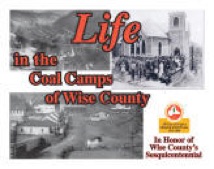The Town of Appalachia lies deep in the coal fields of southwest Virginia. The town once flourished on the coal mining economy, becoming economically dependent on mining as the principal source of income.



Appalachian Heritage Tourism Project, 1993-94

To learn about
the coal camps surrounding the town of Appalachia, and see photos of mining life, see the new book Life in the Coal Camps of Wise County.
The economic situation changed when the mines started scaling back operations in the early 1990s. In 1993, the region's principal mining company released the news that it would be closing its facilities soon. Faced with the rapid decline of the mining industry, and seeing the parallel decline of the town's economy, a grassroots citizen's group formed to seek alternative forms of economic development, with a special interest in exploring heritage tourism.

By joining in a research/teaching partnership with Appalachia's citizens' group, the project director/professor was able to lend assistance to the town's efforts to explore heritage tourism and, at the same time, develop a Fall 1993 Radford University class project that provided an excellent learning opportunity for students to apply their economic anthropology studies to a real-life case.
The Economic Anthropology class was structured with a semester-long class project (fifteen weeks), designed to directly involve students in the process of assessing and refining ideas for Appalachia's development through tourism. The students worked together as a cooperative research team under the professor's direction. The team's challenge was to assess the town's ideas for tourism, research and reshape the ideas, and then to develop a set of "working ideas" on how the town might develop a sustainable form of heritage tourism.
A guiding concept that shaped the team's work was applied anthropology's "community-oriented" approach to development -- to work closely with the community and to plan for the community. Community members held a number of orientation sessions for the students, providing opportunities for them to learn first-hand of the community's feelings about its past and future, it’s reasons for wanting tourism, and the efforts it had already undertaken -- in other words, to orient the students to and for the community. Later, the team made return visits to discuss its ideas with community members.
The research team spent the semester discussing the pros and cons of tourism, brainstorming ways to minimize obstacles and capitalize on the strengths of the region, and researching ways in which tourism could be a sustainable form of economic development.
As the final outcome, the team prepared a consulting report for the Town of Appalachia entitled Appalachia, Heart of the Appalachian Region: Working Ideas for Development. The project and report included the following scope and coverage:
-
•Discussion of the project design and planning considerations for undertaking economic development through sustainable tourism;
-
•Ideas for revitalizing the downtown, emphasizing a culturally-based design that integrates important themes in Appalachian Mountain Culture and establishes the town as a festival center for music and arts;
-
•Ideas for developing heritage-based tourism around the region's coal mining history, including plans for developing a simulated coal mine and reconstructed coal mining camp that would operate as a living history museum;
-
•Ideas for railroad-based tourism involving the development of a working railroad tour, an annual festival, and a railroad museum;
-
•Ideas for developing a wide range of recreational activities to capitalize on the natural beauty and terrain of the mountain landscape, including the development of hiking, biking and horseback riding trails, fishing and tubing activities, and camp grounds;
-
•Ideas for funding and marketing the tourism package, and draw tourists to the region;
-
•Discussion of the importance of combining tourism with other enterprises, such as bed-and-breakfasts and cottage industries, to create more sustainable forms of development.
This project was a mutually beneficial venture -- the class was able to offer the town free consulting assistance to help develop its tourism ideas and, at the same time, the town provided a field site for participatory learning, where students could actually apply their studies and gain experience as practicing anthropologists. The town made use of many of the team's ideas for downtown revitalization and used the consulting report as documentation for grant applications.
Project Director/Professor: Dr. Mary LaLone
Student Research Team:
Wendy Detwiler, Heidi H. Field, Astrid Haggerson, Alice T. Horn, Barbara Jones, Deanna Matthews,
Sarah E. Merkle, & Lin Usack
For Further Reading on the Mining Way of Life and the Applied Anthropology Project:
LaLone, Mary B.
1996 “Economic Survival Strategies in Appalachia’s Coal Camps.” Journal of Appalachian Studies 2(1):53-68.
1997 "The Appalachia Tourism Project: Applied Anthropology in an Appalachian Coal Mining Town." In Practicing Anthropology in the South, Tim Wallace, ed., University of Georgia Press. Pp. 91-101.
2008 "Voices from the Coal Camps: Life in an Appalachian Coal Mining Region." IN Life in the Coal Camps of Wise County [Virginia]. Paul Kuczko, ed. Big Stone Gap, VA: Lonesome Pine Office on Youth with support from the Virginia Foundation for the Humanities.

Photo above:
Appalachia Coal Miners from a Past Time Period (photo provided to Dr. LaLone courtesy of Mr. Lewis Henegar).
Photo left: Appalachia Miner Working Underground (photo provided to Dr. LaLone courtesy of Blackwood Coal and Coke Co.).

